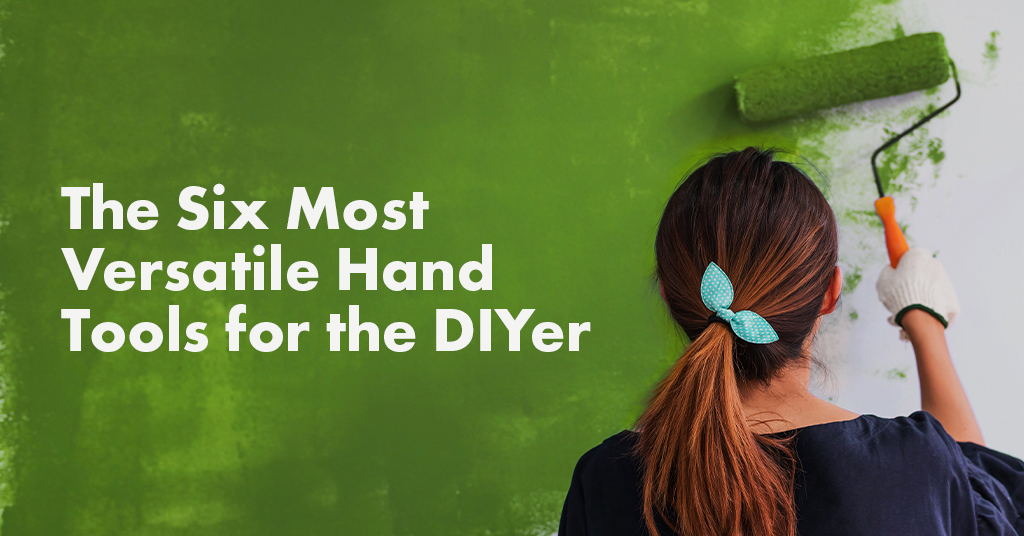The 6 Most Versatile Hand Tools for the DIYer

Regardless of whether you’re just getting started on your first DIY project or consider yourself a seasoned DIY expert, there is probably a tool or tip out there that could be making your job way easier. It might be an essential tool you simply forgot you needed, or it could be a new way to use something that’s already in your toolbox. Even if you know your way around the tool shed, it’s never too late to learn something new.
Worried your DIY tool bag might be missing something? Don’t wait until you’re working to figure out what it is that you forgot. Check out our list of the most versatile hand tools that every DIYer needs below, and don’t miss the handy tips and tricks we have for using each one!
Painter’s Tape
Everyone has used masking tape to keep edges clean during a pain project, but did you know that it can be used in other ways too? TapeManBlue offers some excellent creative uses for painter’s tape, such as creating unique wall art or planning your interior design layout.

Mid-Size and Oversized Wall Plates
Did you know that wall plates for light switches and wall outlets come in different sizes? Mid-size and oversized wall plates are designed to cover more wall space than standard size ones do, which makes them perfect for hiding imperfections on the walls. Don’t worry about painting or fixing the minor damage around your receptacles, simply cover it with a larger wall plate and pretend that it’s just for looks. For more information on wall plate sizing, check out our Ultimate Guide to Wall Plates.
Level
DIYers can’t get far without a level to help them hang photo frames, curtain rods, towel racks, and various other interior decor items. It’s the only way to ensure that whatever you’re building, hanging, or working on is straight and, well, level. A level is essential for every toolbag–but did you know that you can get a digital version on your smartphone too? Levels come in standard, pocket, and collapsible versions, and it never hurts to have a few spares just in case one of them is off. You should always check the accuracy of your level before making a mistake that you can’t take back.

Screwdrivers
Another essential component to any toolbag is a screwdriver. Well, two screwdrivers actually. Philips head screws (those are the ones with a little cross) are more common these days, but it’s always a good idea to have both a Philips and flathead screwdriver on hand, just in case. With these two lifesavers in your toolbag, it’s unlikely you’ll come across a screw you can’t handle. Screwdrivers can be easily magnetized to hold onto screws effortlessly and make whatever job you’re working on a little bit easier. Flathead screwdrivers are also pretty good for prying things open, like a can of paint, so you never know just how one might come in handy.
Tape Measure
You never know what you may need to measure during a project, so you should always keep a tape measure handy. Make sure it has both Imperial and Metric units, which shouldn’t be hard since that’s typically the standard. Family Handyman offers some great tips for easier measuring, from knowing your tape measure’s width to using the tape measure’s hook as a scribing tool.
One way to save time and make your DIY projects a little easier is to learn hand-measuring. Use your tape measure to familiarize yourself with the dimensions of your fingers, hands, and arms. You may discover you have an inch-long knuckle or that the length of your hand measures 4” x 6”. The measurements will be different from person to person, but remembering these dimensions can allow you to then use your hands as a makeshift measuring tape for rough estimates of small distances.

Pliers
A good pair of pliers are one of the most useful and versatile hand tools on the market, and there are many varieties of pliers to choose from. Pliers have countless uses, from bending and straightening things to cutting them, stripping wire, pulling out nails, and more. If you choose to add a set of locking pliers to your tool bag, you can also use them as a clamp for even more potential applications. It’s ideal to have a full set of pliers for a variety of uses, but if you’re only going to get one you can’t go wrong with a quality pair of combination pliers.